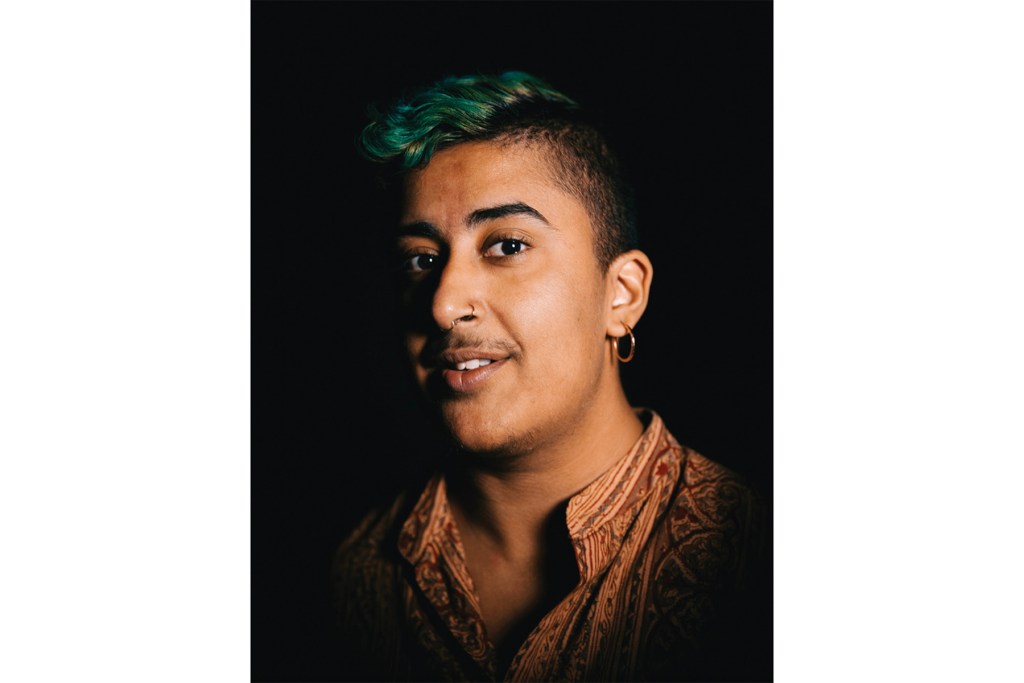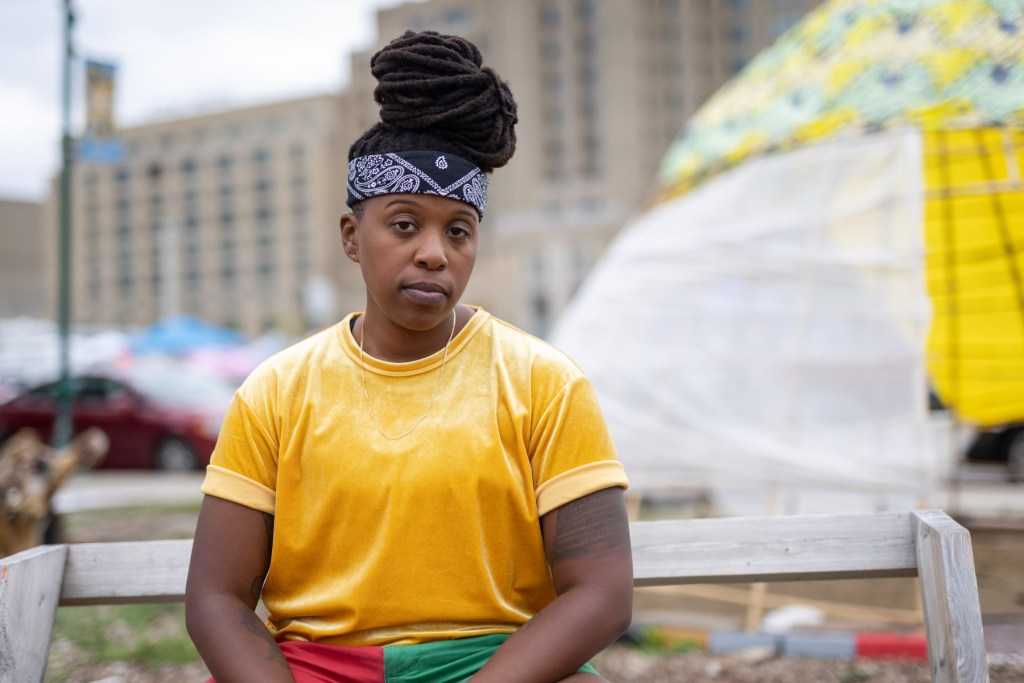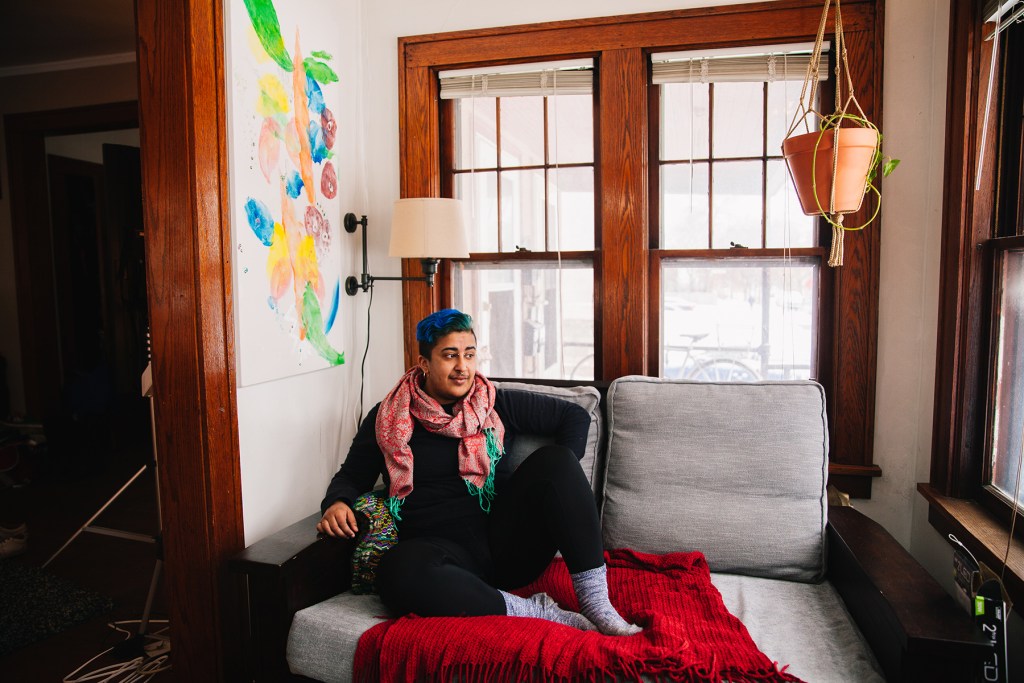When local writer and organizer Aegor Ray agreed to participate in a portrait series of Minnesota’s queer and trans immigrant community, he decided to wear a kurta.
The photographer leading the project, Nancy Musinguzi, had encouraged Ray to wear something that made him feel powerful.
For Ray, this formal, traditional shirt, represented more than his roots in India—Ray had immigrated with his family when he was 3 years old. It signified a level of acceptance from his Minnesota community as well.
The kurta was a gift from a cisgender Indian man, an acquaintance in the Twin Cities, Ray recalled. (Cisgender describes someone whose gender identity matched their sex at birth: that is, a person assigned male at birth who also identifies as a man.)
“After I came out as trans, he reached out to me and said he had these old Indian men’s garments that didn’t fit anymore,” Ray said. “It was so sweet. For trans people, clothes and appearance can be this new thing. I had never thought about that layer of, Do I have traditional wear?”
In the portrait, Ray’s face emerges from the shadows, glowing and proud, framed by the kurta’s soft peaches and rusty reds, and topped by a fringe of hair dyed turquoise.

Photos and stories such as this lie at the heart of Musinguzi’s book and multimedia storytelling project, The Letter Formally Known As Q: Voices From Minnesota’s Queer Immigrant Community. Musinguzi undertook the work to confront and challenge narratives about queer immigrant communities, enabling these communities to define how they are documented and the futures they envision.
“The history of photography has been dominated by and centric to the white gaze,” said Musinguzi. “Now I’m using that practice, inverting it, decentering myself, and giving power and agency back to the subject.”
The Minneapolis-based Wise Ink Publishing recently released the 80-plus-page full-color book. It features five Minnesota people through a series of intimate portraits and candid interviews with Musinguzi.
In addition to Ray, these five include Ngowo Nasah of Cameroon, a web designer, photographed laughing and embracing with her wife and child; Nekessa Opoti of Kenya, a cofounder of the Black Immigrant Collective, discussing growing up in her family’s “little paradise” next to Lake Victoria; Andrea Valdes Valdes of Mexico, a graphic designer, on the fluidity of identity and the joy that comes from her two best friends and her cat; and New York native and scholar Qui Alexander, bundled up in a red parka, on his family’s journey from Puerto Rico, and how his Blackness informs his queerness.

Known as LFKAQ for short, the book is currently available at Birchbark Books & Native Arts, or by order online. The project, including archival interview recordings, will also be available online, on a site designed by the Minneapolis College of Art and Design (MCAD).*
Wise Ink Cofounder Dara Beevas praises the book for representing “uninhibited voices” from LGBTQIA people of color. “As a publisher, my purpose is not only to uplift those voices, but document the work that they do so it’s not unseen and underappreciated.”
‘I get to know them before I pick up a camera’
Musinguzi, 30, who uses they/them pronouns, is a self-described “Ugandan/Liberian, first-generation non-binary/trans American immigrant documentary photographer, multidisciplinary artist, and storyteller.”
Originally from New Jersey, where they were born to a Liberian mother and Ugandan father, Musinguzi relocated to Minnesota in 2014 for an artist residency with the organization Youthprise.
Musinguzi soon fell in love with the community. An avid cyclist, like their father, Musinguzi learned about the bike-friendly city on two wheels, with their Canon Rebel camera in tow. Musinguzi recalls discovering favorite spots like Powderhorn Park, the May Day Cafe, and MCAD. (Musinguzi shot all studio portraits, including the one of Ray, at MCAD and conducted many of the interviews there, too.)
“Minnesota felt real,” Musinguzi said. “It has an element of home I can’t get anywhere else.”
Musinguzi has also plugged into the community by engaging in local arts and activism. Often that involves curating shows and turning up for protests and rallies, and photographing the happenings for posterity. It’s a practice Musinguzi picked up on the East Coast, participating in the Harlem protests for Trayvon Martin after the man who killed him, George Zimmerman, was cleared on criminal charges. Musinguzi’s first photography book, from 2014, was Trayvon Martin: On the Dawn of Freedom, published with the support of the Youthprise residency. More recently, they documented in pictures the People’s Power Love Fest at George Floyd Square, an event and festival that advocated for policing and public safety changes in Minneapolis.
Sahan Journal met with Musinguzi over the summer, in their Minneapolis backyard with their pet bulldog puttering about, at their new art studio in the Northrup King Building, and at the Minneapolis Institute of Art. The photographer returned frequently to a theme of representation that guides their work. The most important part of their practice, Musinguzi says, is gaining consent from their subjects: that is, developing a rapport with the people they photograph, rather than parachuting into their lives.

I get to know them before I pick up a camera. You’re seeing the results of lots of conversation. I could not do this work without talking to people, otherwise they’re just objects.
Nancy musinguzi
“I get to know them before I pick up a camera. You’re seeing the results of lots of conversation,” Musinguzi said. “I could not do this work without talking to people, otherwise they’re just objects.”
Musinguzi always conducts interviews before a shoot, a practice they started with an earlier edition of LFKAQ, published in 2018 and aided by the help of an artist residency with local letterpress Proof Public. In both the first and second editions, these interviews come across more like intimate conversations than formal Q&A sessions. With the interviewees, Musinguzi explores the meaning of queerness (spoiler alert: no two people define it the same way), both in their home or family cultures and in the U.S.
How do queer people of color define safety, borders, and belonging? What brings them joy? And what they would want Minnesota public officials and leaders to know about their experiences as an LGBTQIA immigrant?
Musinguzi doesn’t polish these interviews for print. They intentionally maintain all the idiosyncratic forms of speech, all the “ums” and “uhhs.’ The project is about everyday people, they explain, and there is something extraordinary in what Musinguzi calls each person’s unique mundanity.
The result is an unparalleled oral, written, and digital history of the queer immigrant experience in Minnesota. One narrative may recount the institutional homophobia of U.S. evangelicals in Kenya. Another documents the search for the perfect mango in the Twin Cities. A third explores the need for affordable housing for queer immigrant youth in Minnesota.
The meaning of Three Crabs Fish Sauce and a Street Fighter t-shirt
“I know Nancy and how intentional they are in building out narratives that captured nuanced identities,” said Kaja Vang, a writer and community engagement coordinator for Three Rivers Park District. “They allowed me to take my time to talk. To share the most intimate parts of myself.”
Vang, a friend of Musinguzi, is featured in the first edition, photographed in the fluorescent-lit aisles of United Noodles, a pan-Asian grocer in Minneapolis. Vang was born in Minnesota to Hmong parents who came here by way of Laos and Thailand as refugees of the Vietnam War. Vang identifies as trans nonbinary and queer and uses they/them pronouns.
As with all participants in LFKAQ, Musinguzi encouraged Vang to choose a meaningful location for the shoot. Vang picked the grocer because their parents ran a similar business when Vang was growing up.
One photo of Vang shows them crouching between shelves lined with bottles and jars, sporting black boots, ripped black jeans, and a black tee revealing tattoos. With one hand, Vang pushes a bottle of Three Crabs Fish Sauce toward the camera.

“This fish sauce represents a lot of my culture and the food we eat together,” Vang said. “My family grew up using it. It’s always a fun competition between a lot of my Hmong friends or Southeast Asian friends about which fish sauce is the best.”
Vang’s face, marked by a flash of red lipstick, appears confident, their gaze unflinching yet soft.
Like Ray, Vang also chose a meaningful garment to wear: a tee with a logo from Street Fighter, the ever-popular Japanese video game that debuted in the late ’80s. Vang says wearing this shirt is a symbolic act of defiance directed toward their father—a refusal to match his version of “the perfect Hmong daughter.”
Growing up, Vang would play video games with cousins, aunts, and uncles. “One day I was gaming with my auntie and he came in and said, girls shouldn’t be playing video games,” Vang recalled. Vang didn’t play video games again until after moving out of their parent’s home.
“In general, the Hmong culture is super patriarchal. Gender roles are placed on kids, especially Hmong women. It was very particular to my family as well,” Vang said. Vang chose to get involved in Musinguzi’s project to tell their family’s story and to increase the visibility of queer and trans Hmong and Southeast Asian people in the media.
‘The conditions of my immigration are very different’
Ray, an organizer for the Sex Workers Organizing Project (SWOP) of Minneapolis, says the project gave him the opportunity to discuss the unique details of his experience.
“I’m a high-caste Hindu. The conditions of my immigration are very different. I loved the ability to be specific, to recognize the enormous privileges I had,” Ray said. “What are the different forms of politics in different trans and immigrant experiences? The book allows people to talk about it on their own terms.”
Months after their first meeting at MCAD, Musinguzi arranged a second shoot at Ray’s home, an apartment near Powderhorn. Ray recalls how Musinguzi coached him with light verbal cues: Move your face this way, lean into the light.

One image features Ray, lounging on his couch, wearing all black, except for a pair of fuzzy socks and a red scarf. This time his hair is an electric blue. In another photo, Ray stares directly into the lens through his reflection in a bathroom mirror.
“They held me in a soft confidence,” Ray said. “They showed me a couple of pictures and said, ‘Just look at you.’ I felt both precious and powerful, very special and very myself.”
In hindsight, Ray says this is a bit of a feat, as it was during one of the most difficult periods of his life when he was struggling with mental health issues.
“The fact that I have these beautiful photos of myself—it feels very special,” Ray said. “A reminder that trans life is beautiful even in the midst of struggle.”
*Clarification: This story has been updated to specify MCAD’s role in designing The Letter Formally Known as Q website.




